History – It’s the reason we swing.
Jewelry – It’s what gets our hearts beating.
Gold – It’s the icing on the cake.
Put them all together—an historic gold ring—and you’ve got the makings of a detectorist’s greatest find. And this exactly what happened to me on May 20, 2022.
The Discovery
I’d been nose-deep in research for my Doctor of Education. Occasionally, I’d take afternoon breaks to go metal detecting in local parks. On this particular day, I could only spare a few minutes, so I chose to swing in the yard of the 100-acre property where we were living. I had recently helped the owner move a wood pile onto pallets, so there was a new swath of ground to search.
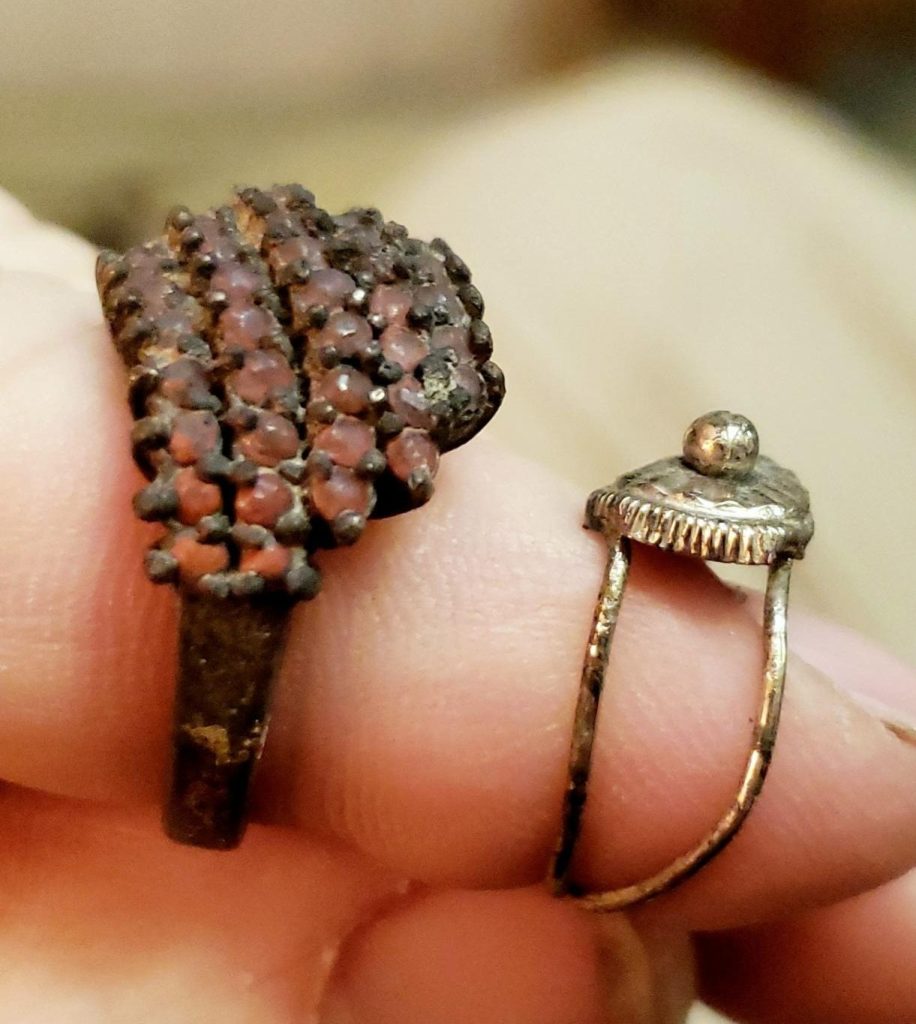
A slight bit of history for this property: there was a rumor that a former resident owned a jewelry store in town and that his wife was fond of swiping rings and burying them on the property. An urban myth perhaps, though two rings I had found earlier in the Spring lent some credence to the possibility. The first was a thin silver ring whose top looks like a stocking hat. The Second was a hefty ring we thought at first was costume jewelry with red glass, but which later proved to be a genuine piece of jewelry housing a collection of tiny rubies!
I wasn’t expecting to find anything special this morning, especially so far from the buildings, but when I swung my Minelab Equinox 600 over a patch of mud, it rang up a solid “26.” Thinking I might have only found a worthless pop-can, I almost ignored it. But it was the first good beep in five minutes, so I dug.
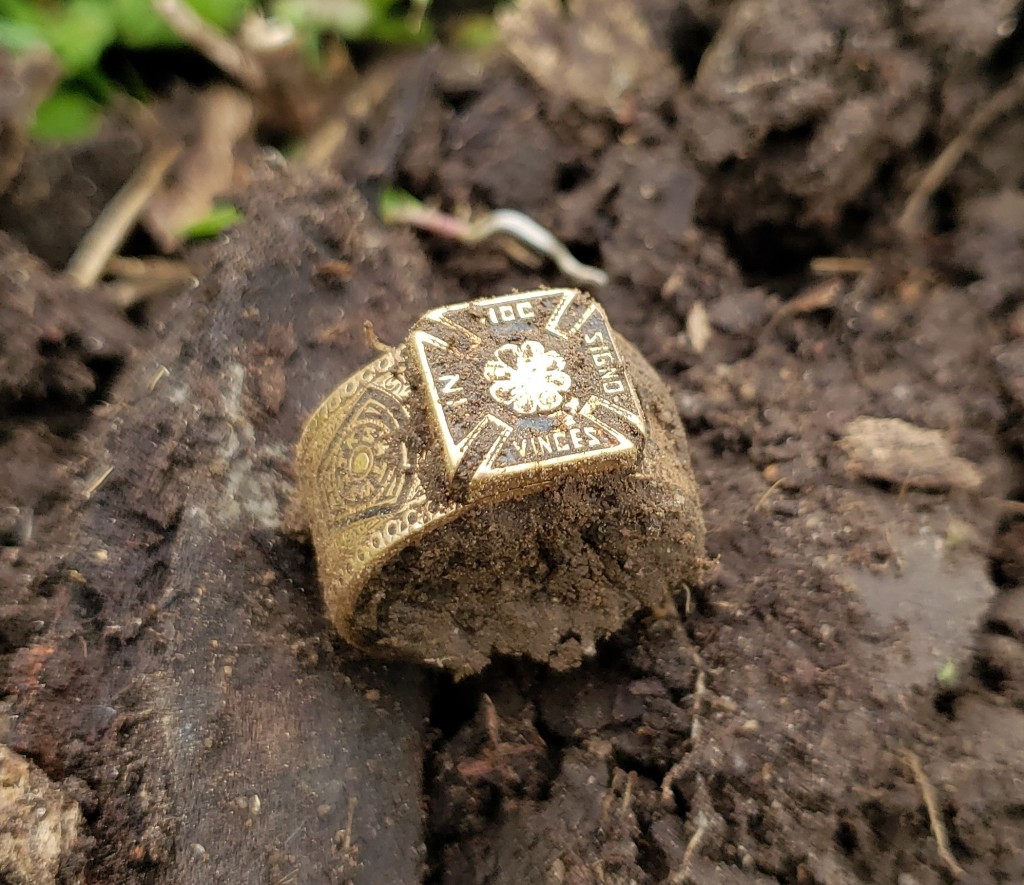
Oh, the feeling you get when you see something like this gleaming through the dirt! My heart was pounding. I poked out the dirt with my finger and immediately knew that this was nothing fake—and nothing modern. I could even see a fancy, old-school script carved on the inside. The designs on the outside became quickly evident as I wiped the dirt away: Masonic symbols of some sort. I simply had to learn more.
The Research
I immediately took the ring inside—five minutes of swinging was enough for me that day! After cleaning it up and weighing it—17g of 18k gold!—I sent photos to the home-owner and then began my research into the histories of both The Ring and The Man.
I began by posting several shots onto www.Treasurenet.com in hopes of getting some solid data on the ring and its design. The wizards on that site led me in the right direction, as you’ll see in “The Ring” section below.
Next, I researched the script and text engraved inside the ring, a process that I hoped would shed light on the ring’s provenance and on the original owner himself. Using www.Ancestry.com and my communications with the current secretary of a Masonic Lodge in SD, I was able to piece together a moderate biography for the former owner of this ring, as you’ll see in “The Man” section below.
The Ring
The treasure-hunting community on www.Treasurenet.com is amazing, and throughout our long discussions (in what ultimately became a coveted “Banner Find”), opinions shifted about what the many designs represented. Through my research and with help from the Lodge Secretary where the original owner was a member, I was able to learn a lot about this ring and the owner’s membership. The following describes the conclusions I’ve accepted from these participants’ vast stores of knowledge:
- The Plumb – This icon depicts either a plumb or “trying to add the plumb to the 47th Problem of Euclid.” While this made no sense to me, it’s an icon that is significant to a Blue Lodge Mason.
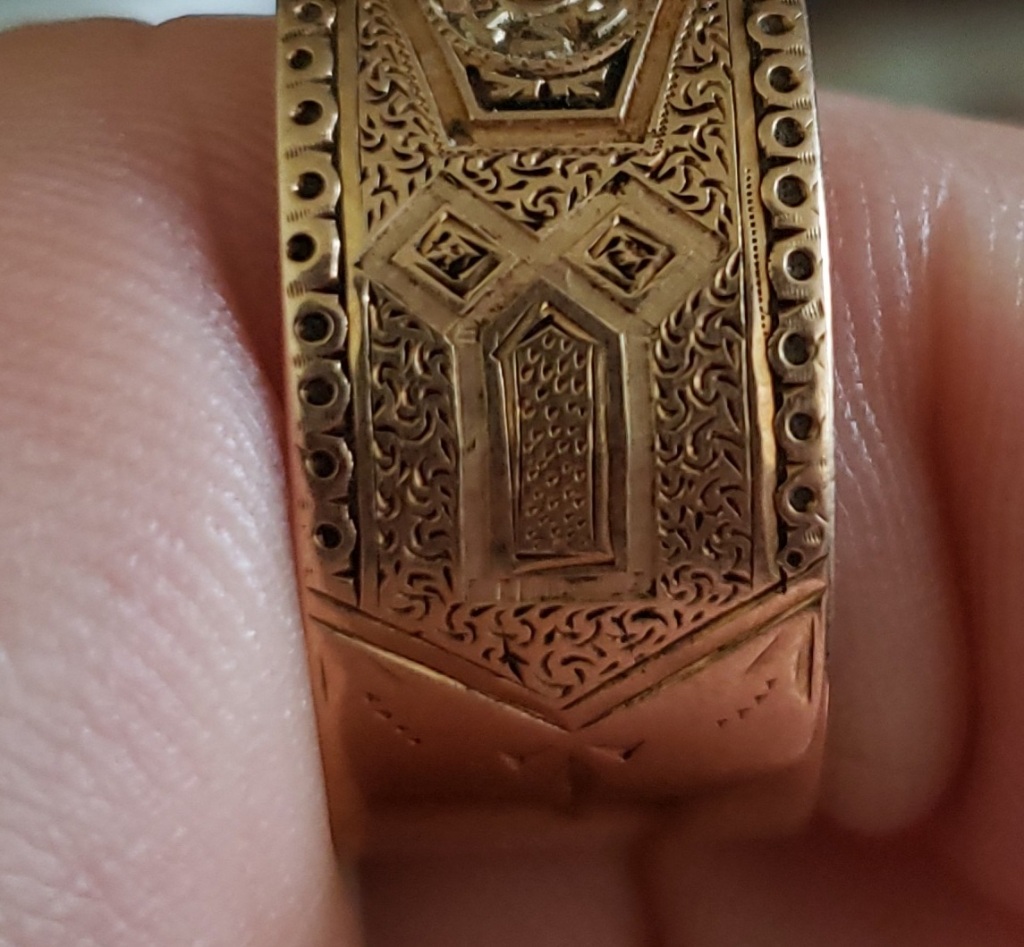
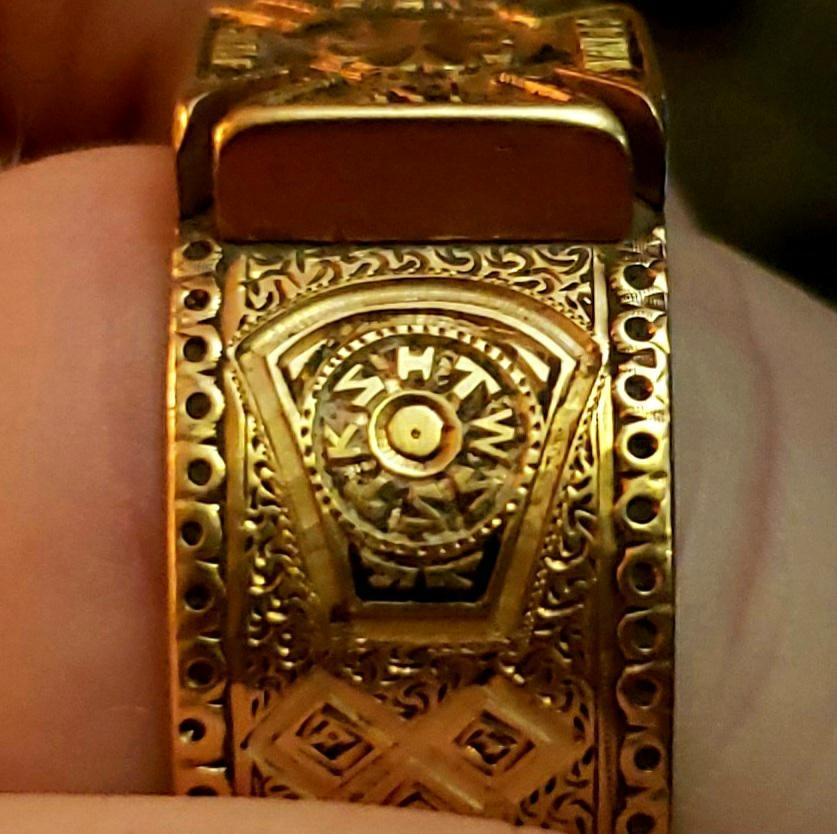
- The Keystone – This icon identifies the original owner as a member of the York Rite. According to pepperj, the acronym “HTWSSTKS” is commonly used in Masonic jewelry. It stands for “Hiram Tyrian Widow’s Son Sent to King Solomon.” This refers to the Legend of Hiram Abif, an important allegory in Masonic teachings, who was charged with the task of building King Solomon’s temple and who died refusing to tell the secrets of the Master Mason. The story symbolizes loyalty and is associated with the highest degree of the Masonic fraternity. According to Blackfoot58, this acronym signifies Royal Arch Masonry, a section of York Rite. According to jewelryguy, the acronym has also been described as “KSHTWSST” which stands for “King Solomon Had Ten Wives, Some Say Twenty.” I prefer the first interpretation, because King Solomon had something like 1000 women in his life!
- The Headstamp – This remarkable piece (which detached from the ring while handling several months later) identifies the original owner as having completed his Templar Degrees in the York Rite. According to Sam Reder, the cross references the Knights of Saint John who were captured and imprisoned on the island of Malta.
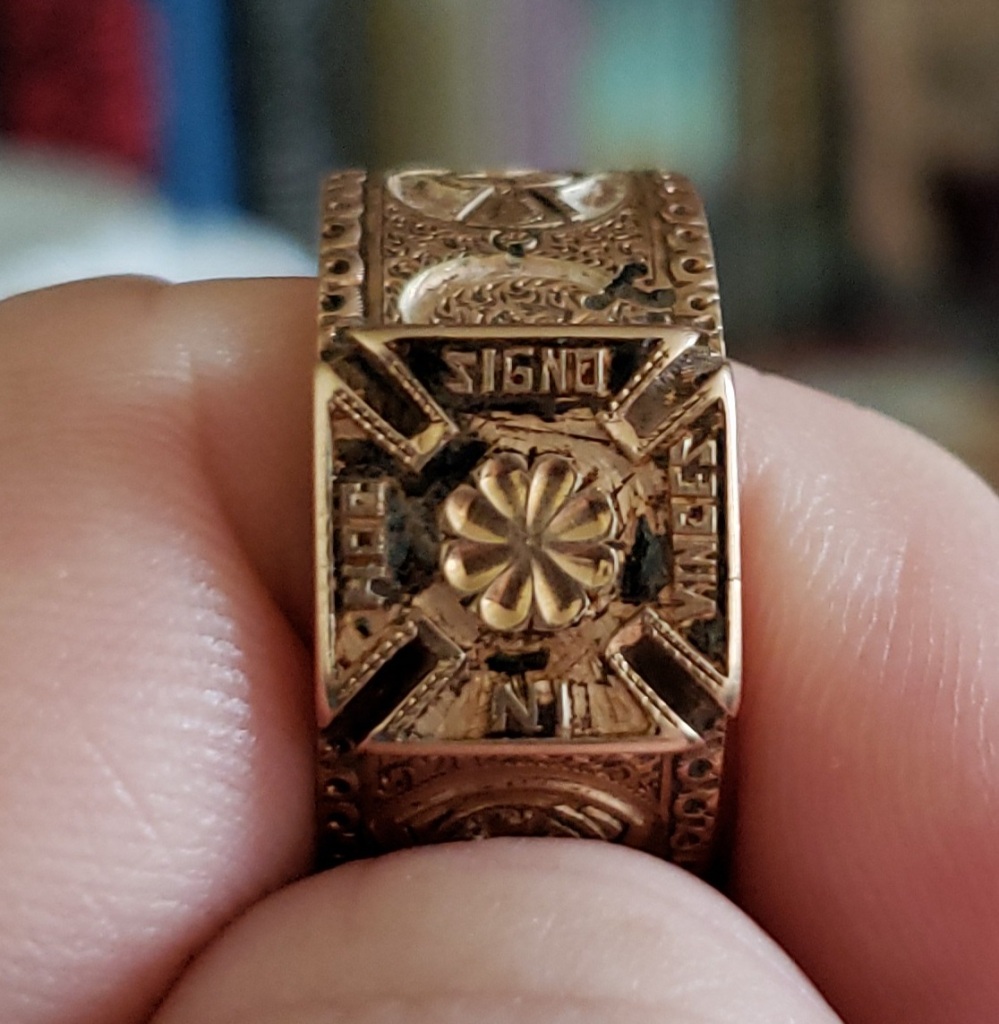
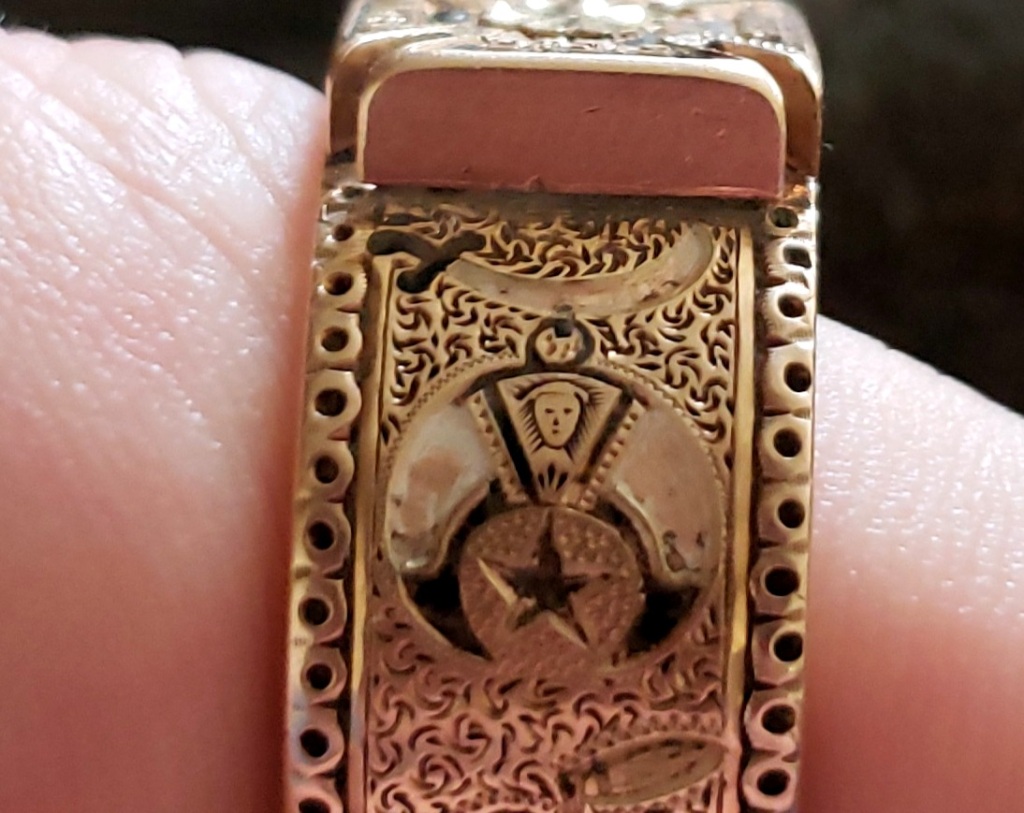
- The Sword – This crescent-shaped weapon symbolizes his membership in the Shrine.
- The Trowel – The trowel is an obvious Masonic symbol representing “the spreading of brotherly love and affection.”
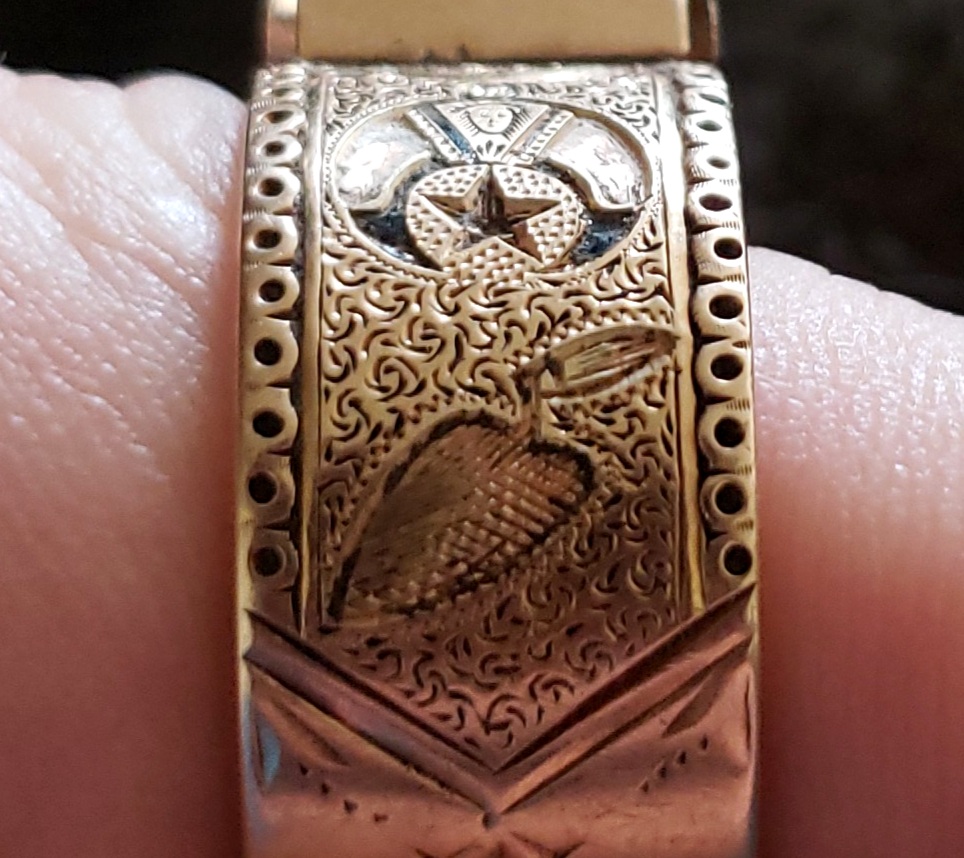
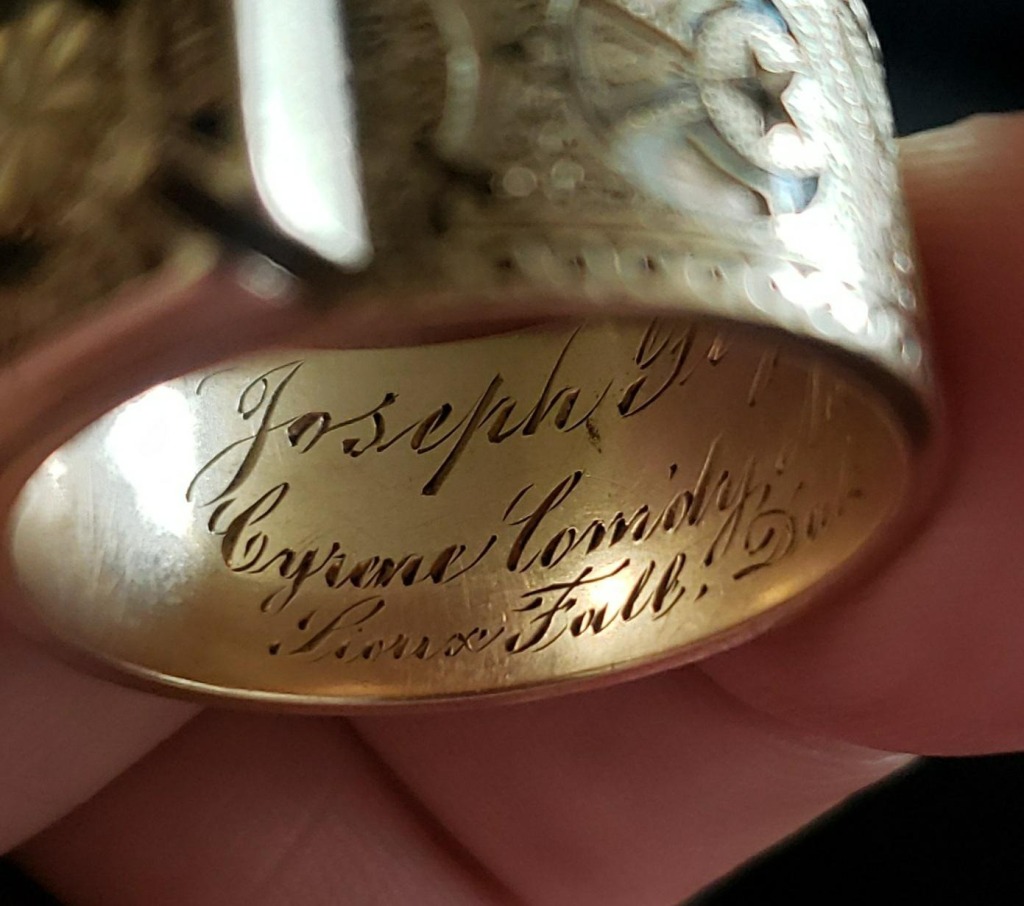
- The Engraving: “Cyrene Com’dy No 2” – This engraving on the interior of the ring says that the former owner was part of the Cyrene Commandry No. 2. I might also add that the “Sioux Falls, Dakota” led me to believe that this ring predates the split of North and South Dakotas into individual states in 1889.
Put altogether, the symbols on this ring suggest that this fellow was a Blue Lodge Mason of the York Rite and a Shriner. I’m not a Mason myself, so I needed a touch of education on what exactly this means, but according to Ambam, the Blue Lodge is the main Masonic organization, and a person must be a member of it in order to join any other appendant body, like the Shrine, York Rite, Knights Templar, etc. Blackfoot58 gave this further insight:
To clear up any confusion about fraternities. Shriners are a branch of freemasonry. They are the philanthropic branch thereof. Masonry has many off-shoots: rainbow girls, DeMolay, Scottish Rite (Consistory), York Rite (Commandry), Order of the Eastern Star and many others. Each branch has its own symbols and history. A piece of jewelry may have symbols from more than one branch. The scimitar with the star is a symbol of The Shrine, but sub-groups use it as well. Very interesting to anyone who appreciates history, ancient wisdom, allegorical stories, etc.
Another interesting tidbit from Sam Reder:
Most lodges do not offer rings to their members so Masons wear rings willingly having to look for a specialist to manufacture them. The ring can follow a pattern of symbologies but in general each one is unique.
Another interesting fact about this ring is that the upper portion accidentally popped off, revealing what some called “a secret compartment,” possibly even identifying it as “a poison ring.” After looking at it closely, I don’t think this is the case, but that it’s rather just a broken bit of manufacturing. Still, the thought that it might possibly have a sinister side makes the ring even cooler—as if it needed help!
The Man
Based upon the name engraved in the ring and the information I was able to glean from www.Ancestry.com, I have been able to piece together the following biography for the original owner, Joseph F_____.
The F_____ family landed in NY from Germany on Feb 10, 1854, and Joseph was born 3 weeks later, in Finley, OH. By the time this first-generation American was 16 (1870), his family had moved to La Crosse, WI. By the time he was 26 (1880), his family had moved a few miles south to Brownsville, MN (the town where I found the ring).
Records indicate that Joseph likely also spent a fair amount of time living in the region of northwestern IA and southeastern SD between 1873-1890. At some point during these years (likely the 1880s), he joined the Fortitude Freemasonry Lodge in Salem, SD. Following his growth through the ranks, he had this fantastic ring commissioned.
On Dec 15, 1890, at the age of 36, Joseph married Bertha L. (originally of Brownsville, MN) in Woodbury County, IA. Two weeks later, on January 1, 1891, he demitted his Lodge membership in good standing. According to Blackfoot58, this demission may have been for religious reasons:
There were issues where many Roman Catholics were anti-Masonic… Suffice it to say that he MAY have left Lodge in order to preserve peace and harmony at home. I’m guessing he would have been older at the time of his nuptials than many men of the day. He would not be the first to succumb to such pressures.
Jospeh F____’s first daughter was born in 1893 in Brownsville, MN, and in March of 1894, the young family moved to Grants Pass, OR, where they’d stay for the at least the remainder of Joseph’s life. Joseph and Bertha’s second daughter was born in 1897 in Oregon. Joseph worked as a bookkeeper and later as an insurance agent for iron loans, continuing in this role past the age of 65.
In 1922, Jospeh owned a Studebaker and was otherwise consider well-to-do. When he died of pneumonia on Christmas Day, 1925, he was able to leave roughly $56,300 to his widow (equivalent to $885k in 2022). He maintained close ties to his family in Brownsville, MN, requesting that his brother Charles be the executor of his estate. Because Charles was not a resident of OR, however, that role went to his wife, Bertha.
Summary and Follow-up
Based upon all the research above, I have concluded that this ring was likely crafted at some point in the late 1880s, and that Joseph himself lost it in the fields of Brownsville, MN, shortly before moving to Oregon, between 1891-1893, I am proud to have discovered it 130 years later! This was definitely not something hidden by the thieving wife of a Jewelry-store owner. It is a true piece of American treasure.
Eleven days after I unearthed this special ring, I handed it over to the homeowner to do with as he wished, and I received the promise that he’d definitely not be melting it! That’s the last I thought I’d see of the darn thing.
Truth is, the homeowner is a great friend of mine who had provided a home for my family during a very difficult period of our lives. For 2.5 years, we had the pleasure of being their next-door neighbors and sharing their land. When, about a year after I found this ring, it came time for us to move on, this friend did something that shocked and humbled me: along with some of the kindest words anyone has ever said to me, he handed me back this gold Masonic ring and told me: “It’s yours.”
This ring is a genuine piece of treasure that I will truly “treasure” the rest of my life, not only for its historical value but also for its sentimental value as a symbol of friendship. Thanks to those who helped me discover the value of this find and for keeping the heartbeat of treasure-hunting alive. Now let’s get out there and find some more history!
©2023 E.T.
